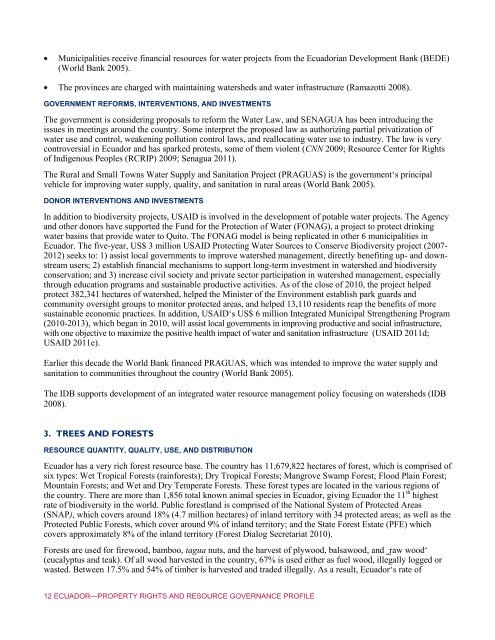ECUADOR - Land Tenure and Property Rights Portal
ECUADOR - Land Tenure and Property Rights Portal
ECUADOR - Land Tenure and Property Rights Portal
You also want an ePaper? Increase the reach of your titles
YUMPU automatically turns print PDFs into web optimized ePapers that Google loves.
Municipalities receive financial resources for water projects from the Ecuadorian Development Bank (BEDE)(World Bank 2005).The provinces are charged with maintaining watersheds <strong>and</strong> water infrastructure (Ramazotti 2008).GOVERNMENT REFORMS, INTERVENTIONS, AND INVESTMENTSThe government is considering proposals to reform the Water Law, <strong>and</strong> SENAGUA has been introducing theissues in meetings around the country. Some interpret the proposed law as authorizing partial privatization ofwater use <strong>and</strong> control, weakening pollution control laws, <strong>and</strong> reallocating water use to industry. The law is verycontroversial in Ecuador <strong>and</strong> has sparked protests, some of them violent (CNN 2009; Resource Center for <strong>Rights</strong>of Indigenous Peoples (RCRIP) 2009; Senagua 2011).The Rural <strong>and</strong> Small Towns Water Supply <strong>and</strong> Sanitation Project (PRAGUAS) is the government‘s principalvehicle for improving water supply, quality, <strong>and</strong> sanitation in rural areas (World Bank 2005).DONOR INTERVENTIONS AND INVESTMENTSIn addition to biodiversity projects, USAID is involved in the development of potable water projects. The Agency<strong>and</strong> other donors have supported the Fund for the Protection of Water (FONAG), a project to protect drinkingwater basins that provide water to Quito. The FONAG model is being replicated in other 6 municipalities inEcuador. The five-year, US$ 3 million USAID Protecting Water Sources to Conserve Biodiversity project (2007-2012) seeks to: 1) assist local governments to improve watershed management, directly benefiting up- <strong>and</strong> downstreamusers; 2) establish financial mechanisms to support long-term investment in watershed <strong>and</strong> biodiversityconservation; <strong>and</strong> 3) increase civil society <strong>and</strong> private sector participation in watershed management, especiallythrough education programs <strong>and</strong> sustainable productive activities. As of the close of 2010, the project helpedprotect 382,341 hectares of watershed, helped the Minister of the Environment establish park guards <strong>and</strong>community oversight groups to monitor protected areas, <strong>and</strong> helped 13,110 residents reap the benefits of moresustainable economic practices. In addition, USAID‘s US$ 6 million Integrated Municipal Strengthening Program(2010-2013), which began in 2010, will assist local governments in improving productive <strong>and</strong> social infrastructure,with one objective to maximize the positive health impact of water <strong>and</strong> sanitation infrastructure (USAID 2011d;USAID 2011e).Earlier this decade the World Bank financed PRAGUAS, which was intended to improve the water supply <strong>and</strong>sanitation to communities throughout the country (World Bank 2005).The IDB supports development of an integrated water resource management policy focusing on watersheds (IDB2008).3. TREES AND FORESTSRESOURCE QUANTITY, QUALITY, USE, AND DISTRIBUTIONEcuador has a very rich forest resource base. The country has 11,679,822 hectares of forest, which is comprised ofsix types: Wet Tropical Forests (rainforests); Dry Tropical Forests; Mangrove Swamp Forest; Flood Plain Forest;Mountain Forests; <strong>and</strong> Wet <strong>and</strong> Dry Temperate Forests. These forest types are located in the various regions ofthe country. There are more than 1,856 total known animal species in Ecuador, giving Ecuador the 11 th highestrate of biodiversity in the world. Public forestl<strong>and</strong> is comprised of the National System of Protected Areas(SNAP), which covers around 18% (4.7 million hectares) of inl<strong>and</strong> territory with 34 protected areas; as well as theProtected Public Forests, which cover around 9% of inl<strong>and</strong> territory; <strong>and</strong> the State Forest Estate (PFE) whichcovers approximately 8% of the inl<strong>and</strong> territory (Forest Dialog Secretariat 2010).Forests are used for firewood, bamboo, tagua nuts, <strong>and</strong> the harvest of plywood, balsawood, <strong>and</strong> ‗raw wood‘(eucalyptus <strong>and</strong> teak). Of all wood harvested in the country, 67% is used either as fuel wood, illegally logged orwasted. Between 17.5% <strong>and</strong> 54% of timber is harvested <strong>and</strong> traded illegally. As a result, Ecuador‘s rate of12 <strong>ECUADOR</strong>—PROPERTY RIGHTS AND RESOURCE GOVERNANCE PROFILE
















